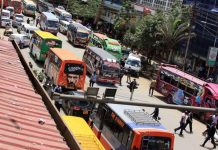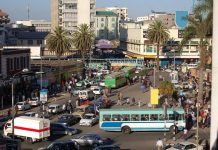The festive seasons is here and with it comes the rush to cities and villages for family reunions and celebrations.
However, the happy season is often associated with a high number of road accidents and calamities.
Recent statistics from the National Transport and Safety Authority (NTSA) show an increasing number of road crashes in the country, with sharp spikes during the festive season.
In October, data from the NTSA revealed that 2,672 deaths occurred on roads in 2019 as compared to 2,286 the previous year, an increase of 16 percent.
Reports also indicate that a significant number of accidents in Kenya are caused by private vehicles and motorcycles while those caused by public service vehicles have generally reduced.
In most cases, road crashes claim three categories of victims — the driver or conductor, passengers and pedestrians or bystanders.
While no one wishes to be a victim of road slaughter, it is important to know what to do in case you witness or are involved in a road crash.
What to do as a driver
You are the responsible party in the event of an accident, meaning that if you are not seriously injured, you are best-placed to describe what happened, find help and discuss insurance and compensation claims.
Whether in the wrong or not, this is what you are supposed to do immediately after a crash:
1. Check yourself for injuries. This is the first thing you should do before thinking of helping others or getting out of the car. Try to find your balance and gain awareness of what happened, and in case you are injured, call for help either from people passing by or the police. If seriously injured, try not to move and wait for emergency personnel.
2. Never flee from the scene of the accident, as is the habit of some motorists, especially those driving passenger service vehicles (PSVs). The right thing to do is to remain at the scene to assess injuries or fatalities. You should also call for help from the police and emergency service providers.
3. Stay calm and do not act in panic. It is important that you remain calm and control your temper following an accident so you can make the right decisions and avoid quarrels with other parties involved in the crash.
In case of panic, take a deep breath to refocus, or delegate tasks to other people at the scene. You should also guard against being affected by other people’s reactions. Staying calm and collected can prevent panic within the group as well as minimise damage.
4. Check on the well-being of your passengers. If you’re not too hurt to move, check on the other passengers in your car. If any is injured, try to call the police or emergency services for help. You can also ask a bystander to call for help. In case someone is critically wounded, do not move the person’s body unless there is danger in leaving the person in a particular position. Spinal injuries are sometimes the result of moving accident victims without the guidance of a medic.
5. Secure the scene. If there are minor damages, you can drive your vehicle off the road in order to prevent traffic disruptions. In cases where it’s difficult to move the vehicle, you should turn on the hazard lights and place the sign beside it. You should also remember to turn off your car’s ignition and turn on your emergency flashers to let other drivers know that you have stopped. If it is night-time, you can also ignite flares to warn oncoming motorists.
It is also wise to provide a barrier using your vehicle and others at the scene. Make sure barrier vehicles have four-way flashers turned on to warn any oncoming motorists. Put up the warning sign at least 50m from the site of the accident, or at least 100 metres away if the traffic is moving quickly.
6. Take note of the accident scene by checking for the number of cars involved, the number of victims and the extent of their injuries and fatalities, if any. Also check for fire, smoke, the smell of gas, broken glass, jagged metal and oil spillage. You might also want to check for children and take them to a safe location if they are not injured.
7. Call the police and emergency services. Call the police (999, 112, 911) the ambulance service and the fire brigade (999 or 020-2222181/ 020-2222182/ 020-2344599) or the Kenya Red Cross Society (1199). Do not move anything at the scene of the accident before police arrive, unless this is essential, in order to protect casualties and for the safety of other road users. If possible, take photographs of the scene before moving people and vehicles.
When police, medics and other responders information such as your location and the number of victims. In describing the location, include landmarks that would help them find you and explain the nature of injuries so they can plan their actions.
8. Provide First Aid. Now that the scene is secure, you can start giving First Aid using the kit in your vehicle as you wait for the police and emergency services. AA Kenya says you should try as much as possible to keep your hands off the victims and not to move them unless absolutely necessary. Check if they are responsive by calling out to them and reassuring them, and stay with them until help arrives.
9. Exchange contact and insurance information with the other people involved in the accident. This includes name, phone numbers, insurance company details and policy number, sand car details such as the model, colour and plate number.
Once the police arrive, get the name and badge number of all responding officers. You can also ask the responding officers where to obtain a copy of the accident report as your insurer may ask for it when tou file the claim. Write down the names and addresses of all parties involved, including details of passengers witnesses.
What to do as a passenger
1. Stay calm and wait for help. Do not panic or lose your temper as it may worsen the situation and cause others to panic.
2. Assess the situation and study your surroundings. Ensure you check yourself for injuries and do not attempt to move if you feel you are unable to. Wait for help instead.
3. Be sensitive about you how you feel even when there are no visible injuries. Depending on your condition, you should try to exit the vehicle and establish the condition of others involved in the accident.
4. If possible, call the police and emergency services for help. Information you gathered about the scene will guide your conversation with them.
5.Try to offer First Aid to the other casualties and remember not to move them much as this could result in severe injuries, especially to the spine.
6. After exiting the vehicle, get out of harm’s way. You can, for instance, wait a good distance away from the scene in case a fire breaks out.
7. Exchange information with the driver and other passengers and establish the damages in order to understand the kinds of claims you can make. It is very important to help the police determine who was at fault, thereby write an accurate abstract. You can do this by collecting evidence through taking pictures of injuries and those that capture the relative positions of both cars on the road. This will help you build a strong case for an insurance claim.
What to do as a passer-by or good Samaritan
AA Kenya says you should:
1. Approach the scene with caution and assess if the prevailing conditions are safe. If the accident took place on an extremely busy highway, it may not be wise to get out and try to stop traffic. AA says only police can clear or redirect traffic because they are easily noticeable in their uniforms and reflective gear, and motorists respond better to their instructions.
2. Call the police and emergency services. Be sure to give clear directions and descriptions of the scene and offer First Aid as you await their arrival. You can also identify people with better First Aid training as they can provide better care for the victims and relieve you or ease the strain. As you offer help, remember your own safety is paramount.
3. Look out for hazards such as broken glass, jagged metal and oil spillage.
4. Try as much as possible to keep your hands off the victims as it might cause further injuries, and check if the victims are responsive by calling out to them. In addition, reassure the passengers that help is on the way so they can remain cal calm and if possible, stay with the victims until the help arrives.
SOURCE: allafrica.com








![Top 20 Used Cars to Avoid Buying in Kenya – [PHOTOS]](../../../blog/wp-content/uploads/2013/11/top-used-unreliable-cars-to-avoid2-80x60.jpg)

![Top 20 Used Cars to Avoid Buying in Kenya – [PHOTOS]](../../../blog/wp-content/uploads/2013/11/top-used-unreliable-cars-to-avoid2-100x70.jpg)





